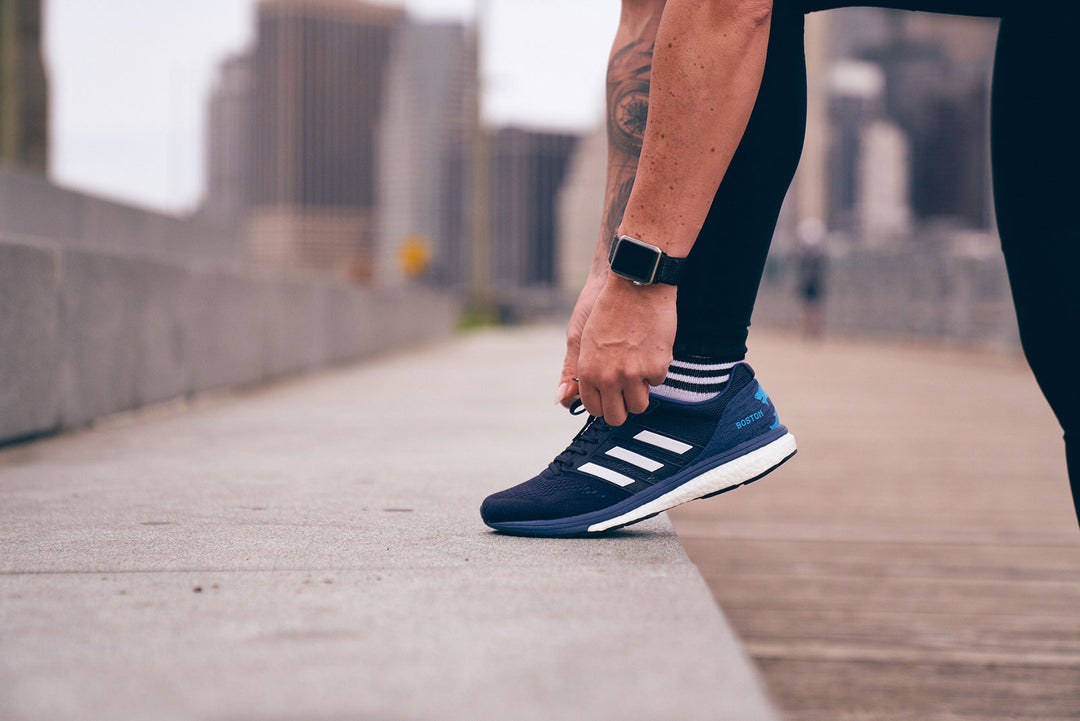10 Strength training exercises for runners
Last Updated:
- Most featured running blog, past 6 years
- USATF certified running coach
- Experienced endurance athlete
- 7 marathons
I recently asked you guys on my Instagram about topics I should cover. The question I got asked the most was: “How about strength training for runners, Sabrina? – How do you do both?”
This is a great topic since I have been doing both long-distance running and strength training for runners for the last 7 years. This is where my expertise is and what I keep practicing with my clients:
Strength exercises for runners are crucial for great running performance. How do you combine strength training and running?
Does strength training make you a better runner? Yes, it does. So let’s explore the 10 best strength training exercises you can do to take your running to the next level.
The ultimate guide to strength training for runners
If you want to be the fastest, healthiest, strongest runner you can be, work these 10 training exercises into your routine as soon as you can. What type of strength training should runners do?- Ab Wheel Rollout
- Planks
- Squats
- Weighted Lunges
- Deadlifts
- Wall Sits
- Standing Calf Raises
- Pushups
- The Superman
- Leg Raises
The best strength training exercises for runners
Ab Wheel RolloutThis is one of my all-time favorite pieces of equipment to utilize for working out the hip flexors and lower abs. It’s also a strength training exercise you can perform at home!Be sure to utilize the proper form - Start from your knees, keep your core tight, don’t arch the back, and perform the movements slowly.As a movement for strengthening your core, there are many more effective options than utilizing an ab wheel rollout.Studies have shown that using an ab wheel isn’t any more effective at activating the upper or lower rectus abdomens muscles (LRA and URA) than your typical crunch.But the ab wheel is effective at working out the hip flexors, triceps, shoulders, wrists! And even though the abdominal muscles aren’t directly targeted, you can still get the added benefit of a crunch in each movement.You can find my favorite ab wheel here - as well as a handy list of my favorite running gear. Some of the tools to my success, you could say!
Planks for a Stable Core and Better Running Economy
Now, although the ab wheel may not exactly target the abdominal muscles, the plank definitely does!In fact, I like to train my core multiple times a week because of how effective it is at building balance and stabilizing the trunk during running.For distance runners, in particular, core exercises can help increase your running economy - which is defined as the efficiency through which you consume oxygen and use it to produce motion.A strong core means you will be much more efficient at utilizing your aerobic capacity to drive your running farther and faster. This is especially important while running a marathon.Squats for More Explosive Leg PowerYes, you can do some legitimate weightlifting, even if you are a distance runner like I am! In fact, I can credit squats as one of the most powerful tools in my running toolbox.Squats aren’t just a way to get great looking legs. They can also contribute to developing powerful muscle fiber recruitment for explosive movements.Or in other words, squats can make you a faster runner.All of which is incredibly important when you are trying to keep pace during a lengthy run. And even on flats or hills (Heartbreak Hill of Boston Marathon fame, anyone?), squats can help you accelerate quicker where it counts!Weighted Lunges to Prevent Runner’s KneeWeightlifting, in general, will give you stronger knees. But weighted lunges, in particular, are an awesome movement for strengthening your joints and can contribute to preventing Runner’s Knee.Just like the squat, you can really do a world of good for your knee joints by regularly doing sets of lunges.Because Runner’s Knee is often caused by weak stabilizer muscles around the knee itself, lunges can build up the quadricep muscles in the area that helps most in preventing knee injuries.Although it’s true that compound movement strength training is more common for sprinters and shorter-distance runners, there is still a beneficial carryover for distance running as the joints continue to strengthen with progressive workouts.Some lunge variations to also try:- Jumping Lunges
- Backward Lunges
- Curtsy Lunges
Training plan for strength training for runners
How many times a week should a runner do strength training? Now that you know the 10 best exercises for runners, let’s lay out a training plan to maximize their benefits.As a casual runner, a running beginner, or even during marathon training I recommend at least 3 days of strength training added to your regular running schedule. Make sure that you run on the same day that you work on your legs.The following day will be a rest day. During marathon training, it is key to lift around the long runs. Of course, when you are training for a big race, running should be your main focus.Your goal should be more build around becoming a stronger and more efficient runner through weight training.If you become too sore from the gym and you can’t perform during your training runs, strength training doesn’t do anything for you. It will more likely prevent you from running your personal best.During marathon training, I went up to 14 miles in the morning and trained my legs at night.It is very important to listen to your body: at some point, I realized I have to skip the leg day on my long run day and reschedule it for the next day. See how you feel and don’t hit the gym when you are tired or sore from your run that day.How to balance weightlifting and running without overtraining
Should I run and strength train on the same day? The days when I work on my legs are also the days where I run. The reason I do it that way is that I experienced better results.There were times where I didn’t do it that way and I was just sore all week. This means though that I work out twice per day on these days. I run in the morning and then I train my legs at night. This is also how I prevent overtraining.My training plan varies from week to week but I always include 3 leg days (quads, hamstrings, and glutes) plus 2 upper body days in my schedule per week. I train my abs every other day after my other workouts.On top of that, I run 4 days a week with a long run on the weekends. Mondays and Saturdays are usually my days off. Don’t feel intimidated.This doesn’t mean you have to do as much as I do, to be in shape or become a faster, stronger runner. Find your own grove and keep embracing yourself.How many rest days should you have
The secret here is to find your own way that works best for you, take enough time off and nonetheless fuel your body with the right nutrition and supplements.Running long distances is physically draining, and adding weight training to that burden risks overstressing the body and decreasing your conditioning.Rest days are super important not only if you are doing both strength training for runners and running. Mix in a few rest days from all workouts.It’s imperative that you give your body the time to recover and repair the damage done by intense training.Work on your legs one day, have another day where you focus on your upper body and use the other day for core and stability exercises.
Does strength training make you a better runner?
There is a reason why more and more runners and not only the elite people are hitting the gym nowadays.Runners' legs have to be prepared for the great demands of an endurance event like the marathon which is why strength training for runners is as important as your long run on the weekend.Besides that I think that an athletic body looks way nicer than just a skinny body of a long-distance runner and weight training is beneficial in many ways.Of course, strength training for runners will not only make you stronger and faster but also aid in injury prevention.Running the NYC Marathon without any struggle or pain with negative splits for 26.2 miles and a super-fast recovery of fewer than 7 days is a good example that strength training is also the right decision also for marathoners.Taking myself as an example I can only promise you that a great balance between strength training for runners and running training makes you a stronger runner long term.After completing my first marathon (TCS NYC MARATHON) in 2017 I realized in full effect how strength training plays a huge role in how well marathoners handle and recover from the challenge of running 26.2. miles.Frequently asked questions about strength training for runners
Here are some of the most frequently asked questions about weight training for runners that I have been getting from my clients and my community on social media.How many days a week should a long-distance runner do strength training?
For beginners: don’t train any more than twice a week. Remember, you are a runner first and foremost - strength training is only supplementary to your overall training.If you reach the point where you are sacrificing energy for runs, or your running form is breaking down, it’s best to dial back. Beginners should be 85% cardio and 15% strength training.For experienced runners: You could probably strength train 3-4 days out of the week. Should you though?This is often because more experienced runners have better joint strength than a novice runner and can handle the extra load of weight - on top of additional endurance training.Again though, there is no hard and fast rule for balancing strength training and endurance training as a runner. It really depends on your overall threshold for endurance, stamina, and physical strength.Sprinters incorporate strength training more so than distance runners, but you can find a balance that works for your unique levels of strength.Should runners lift heavy?
Define heavy!Should you lift so heavy that you injure yourself and interfere with your overall running schedule?Hell no! Lift weights that are within your physical range. So, you first need to determine the number of reps at a certain weight that gets challenging around the 6th-10th repetition.Your weightlifting should be challenging enough to make you stronger. You shouldn’t be performing 15 - 20 repetitions with lighter weights if you are truly trying to get stronger.The 15-20 rep range is catered more towards endurance training, and although endurance training is amazing, it’s counterproductive to go on long runs and then turn around and do endurance training with weights as well.Best to keep it in the strength training range!How often should runners do core training?
If your goals are to increase your running economy and add stability to your overall frame, it makes sense to at least train your core once a week.Research has shown that strength training once a week is all you need to increase your overall strength - given that you are working out intensely enough.But to minimize the risk of pulling an oblique or running with an insanely sore set of abdominals, it makes sense to spread the intensity out during the week - say 2-3 separate core workouts. That way you can break up some of the fatigue and soreness.Should I run and strength train on the same day?I say you should! It will depend on your overall training levels, but in my experience, if I did strength training on a separate day, I would be way too sore to run at my most effective.Depending on how close you are to a race, or how much you are prioritizing miles over mass, it will depend on if you start the day off with a run or with weights.Personally, though, I like to run in the morning and do weights at night. I’m a runner first, after all, and love to give whatever fuel I have in the tank to my running. By the time the evening comes around I usually catch a second wind and hit the weights!What exercises make you faster?
The best exercises for increasing running speed are those that build explosive strength. Sprints, squats, deadlifts, and lunges are all great compound movements that will build explosive leg strength and keep your pace strong where it counts.Accelerating, when you need it most, is an underrated aspect of distance running. And compound movements are proven to increase your running speed.Are squats good for runners?
Yes, squats are great for runners - distance and sprinters. You can strengthen your glutes the most with squats and stabilize your entire posterior chain with the right prescription of squats (and their variations).Middle distance runners can benefit from resistance band squat jumps, as they lead to a stronger neuromuscular performance overall.Because neuromuscular performance is such a crucial aspect of successful running, squats are your secret weapon for running performance.During a marathon, in particular, your brain determines your overall musculature function - so increasing neuromuscular endurance will mean your muscles can adequately contract without excessive fatigue and slowing down.Won't adding muscle make me slower?
This is actually a myth. After all, many master endurance trainers concurrently train both strength and endurance training at the same time.A biological mechanism called the “Concurrent Effect” results, meaning that instead of seeing negative run times, adding more muscle actually leads to faster movements.In other words, through the concurrent effect, muscle size and endurance strength balance each other out.Unless you are becoming a bodybuilder and putting on some serious muscle, you will not see any negative times during your race.If you are a serious enough runner, you will naturally balance out strength training with endurance training to not impede your overall running performance.Can I workout twice a day?
Simply put, you need to at least have 2 days to rest and recover. Overtraining is from pushing yourself for too long without adequate rest.There are a million and one definitions and examples of overtraining that people cite, but the major culprit of overtraining is not taking enough days off.Also, make sure you aren’t hitting the same group of muscles for days on end. It’s smart to vary your workouts and focus on “splits”. Core/running on one day, running and legs on the other, and running and upper body the next.Play around with what works best for you!









